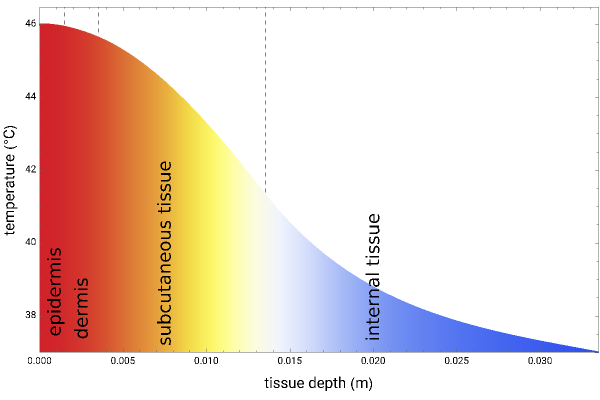Temperature Distribution in Four-Layer Skin Tissue
Temperature Distribution in Four-Layer Skin Tissue
This Demonstration models the temperature distribution of four skin layers subjected to an external heat source. Human skin is modeled as a four-layer structure consisting of the epidermis, the dermis, the subcutaneous tissue and an internal tissue. Assume that each layer is homogeneous, and assume that blood perfusion, thermal conductivity and heat capacity are constant in each layer. Assume also that the layers are perfectly bonded to each other to enable a continuous flow of heat across the interfaces.
Details
Details
Two-dimensional steady-state heat transfer in biological tissue is governed by the Pennes bioheat equation[1]:
2
∂
∂
2
x
2
∂
∂
2
y
ωρ
C
p
k
T
b
q
m
k
q
ext
k
with boundary conditions:
∂T(0,y)
∂x
∂T(L,y)
∂x
∂T(x,0)
∂y
T(x,H)=
T
b
and
Q=
|
Here:
L
H
f
x
y
T
T
b
ω
C
p
k
k
e
q
q
ext
Q
These equations are solved with the built-in Mathematica function NDSolve, using a different set of parameters ,, for each skin layer.
ωρ
C
p
k
q
m
k
q
ext
k
You can vary the intensity and length of the external heat source and the location in the skin and to determine the temperature distribution of the skin tissue.
Q
x
y
References
References
[1] F. Xu, T. J. Lu, K. A. Seffen and E. Y. K. Ng, "Mathematical Modeling of Skin Bioheat Transfer," Applied Mechanics Reviews, 62(5), 2009 050801. doi:10.1115/1.3124646.
Permanent Citation
Permanent Citation
Clay Gruesbeck
"Temperature Distribution in Four-Layer Skin Tissue" from the Wolfram Demonstrations Project http://demonstrations.wolfram.com/TemperatureDistributionInFourLayerSkinTissue/
Published: January 10, 2020
